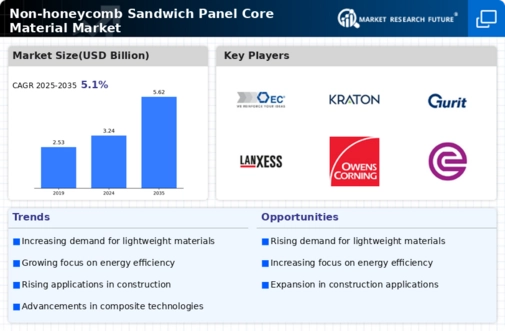Sustainability Initiatives
Sustainability initiatives are becoming a pivotal driver within the Global Non-honeycomb Sandwich Panel Core Material Market Industry. Governments and organizations are increasingly prioritizing eco-friendly materials in construction and manufacturing processes. Non-honeycomb sandwich panels, often made from recyclable materials, align with these sustainability goals. For instance, the use of bio-based resins and recycled content in panel production not only reduces environmental impact but also meets regulatory requirements. As the market evolves, the emphasis on sustainable practices is expected to propel growth, with projections indicating a market value of 5.62 USD Billion by 2035.
Technological Advancements
Technological advancements play a crucial role in shaping the Global Non-honeycomb Sandwich Panel Core Material Market Industry. Innovations in manufacturing processes, such as improved bonding techniques and enhanced material formulations, are leading to the development of high-performance panels. These advancements enable manufacturers to produce panels with superior thermal insulation, fire resistance, and durability. As industries seek to enhance product performance and meet stringent regulations, the adoption of advanced technologies is likely to accelerate. This trend may contribute to a compound annual growth rate of 5.14% from 2025 to 2035, reflecting the industry's commitment to innovation.
Growth in Construction Sector
The growth in the construction sector significantly influences the Global Non-honeycomb Sandwich Panel Core Material Market Industry. As urbanization continues to rise globally, there is an increasing demand for efficient building materials that can meet modern architectural requirements. Non-honeycomb sandwich panels are favored for their versatility, ease of installation, and thermal efficiency, making them ideal for various applications, including facades and roofing systems. This trend is expected to drive market expansion, with the construction industry increasingly recognizing the benefits of these materials in enhancing energy efficiency and reducing overall project costs.
Increased Focus on Energy Efficiency
The increased focus on energy efficiency is a driving force in the Global Non-honeycomb Sandwich Panel Core Material Market Industry. With rising energy costs and growing environmental concerns, industries are actively seeking solutions that enhance energy performance in buildings and vehicles. Non-honeycomb sandwich panels provide excellent insulation properties, contributing to reduced energy consumption for heating and cooling. This focus on energy efficiency aligns with global initiatives aimed at reducing carbon footprints and promoting sustainable practices. As a result, the market is poised for growth, with stakeholders increasingly investing in energy-efficient materials to meet regulatory standards and consumer expectations.
Rising Demand for Lightweight Materials
The Global Non-honeycomb Sandwich Panel Core Material Market Industry experiences a notable increase in demand for lightweight materials across various sectors, including construction and transportation. This trend is driven by the need for energy efficiency and reduced transportation costs. Lightweight materials contribute to lower fuel consumption in vehicles and reduced structural loads in buildings. As a result, manufacturers are increasingly adopting non-honeycomb sandwich panels, which offer superior strength-to-weight ratios. The market is projected to reach 3.24 USD Billion in 2024, reflecting a growing preference for innovative materials that enhance performance while minimizing weight.


























Leave a Comment